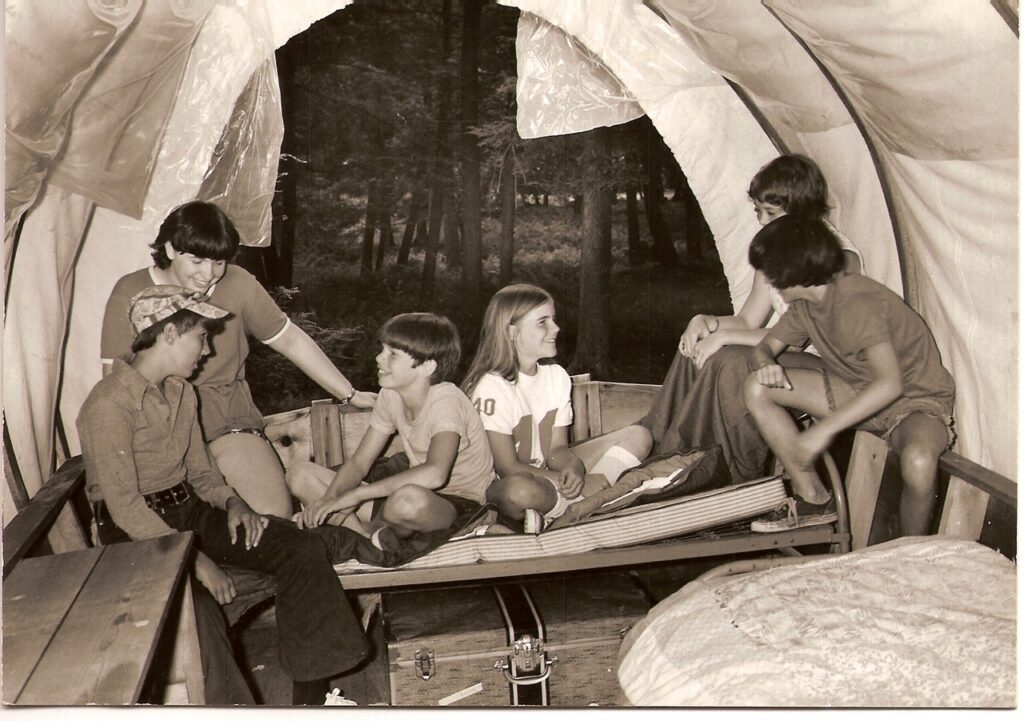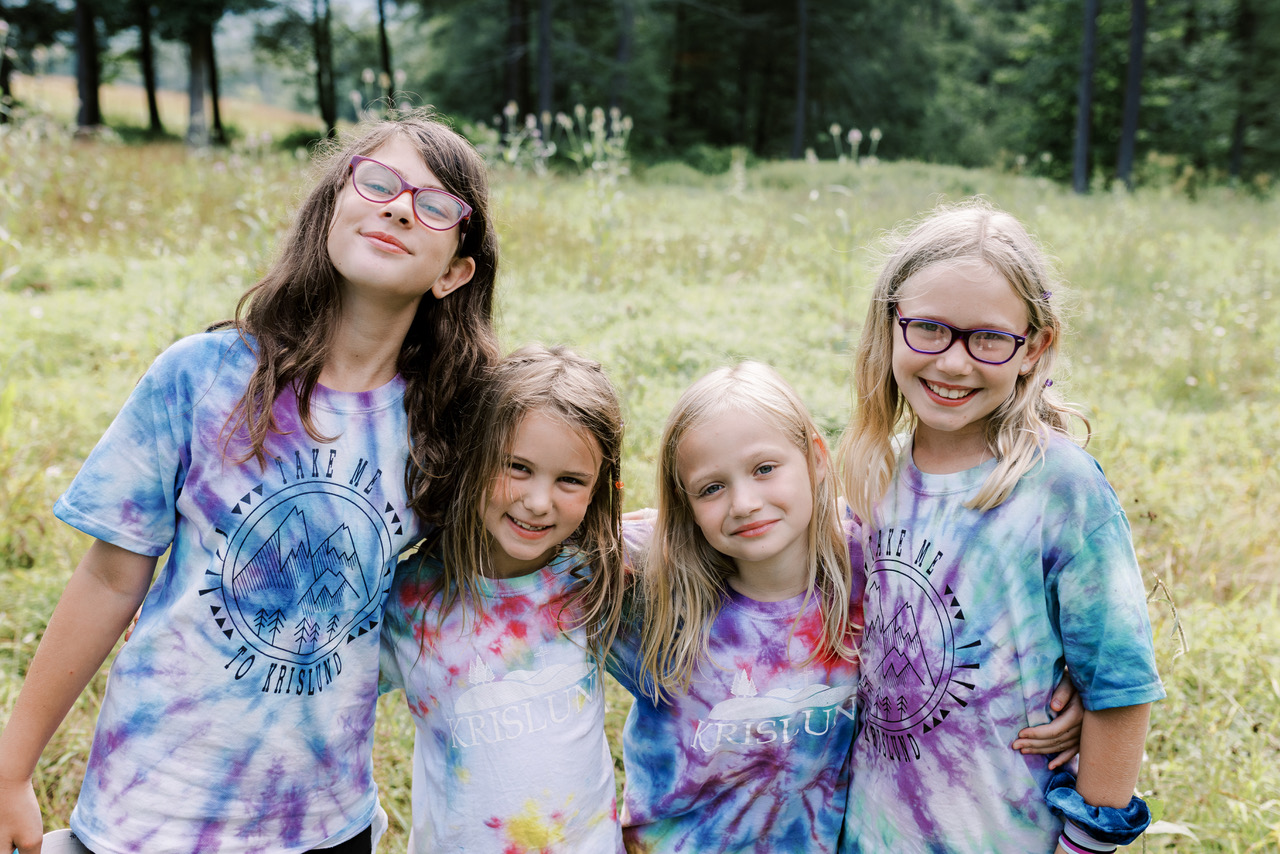As you make the scenic trek toward Krislund Camp and Retreat Center in Madisonburg, you can almost feel yourself slipping back in time.
Winding through Amish farmlands and up the twisty mountain road approaching the entrance to the camp, cell phone service fades almost completely away, leaving you practically as untethered to technology as the first Krislund campers were 60 years ago.
It’s a fitting way for kids to mentally prepare to leave behind texting, TikTok, video games and other trappings of modern life for five nights of what Camp Director Josh Boyd calls “a shift toward traditional camping”—an intentional move from Krislund’s pre-pandemic iteration as a fast-paced, activity-driven program to a slower, low-tech, relationship-centered experience.
Kids seem hungry for that authentic camp experience, says Program Director Kealy Daye. She notes that Krislund features everything from a high-ropes adventure course and rock climbing walls to a 65-foot giant swing and a zipline. “Although they definitely do enjoy that stuff, we’ve noticed that kids seem to have more fun at the simple activities than anything else. They love hanging out in a hammock or on a hayride, just chillin’. It’s been kind of unexpected.”
Boyd adds, “We brought back having a campfire every night where they can debrief, talk about things and get to know each other, versus just going from one activity to the next until they’re worn out.”
This return to the basics has not gone unnoticed.
“We have alumni actually say, ‘Wow, this feels very similar to camp in the ’70s and ’80s,’” Boyd says.
Boyd and Daye take that as a compliment, because as Krislund celebrates its 60th anniversary this year, many alumni from the early days say their experience at the camp was so impactful that they have stayed involved and in touch for decades.
Building a camp
Located in the valley between Nittany Mountain and Madisonburg Mountain, the farmland that would form the basis for a new Presbyterian church camp was purchased by the Huntingdon and Northumberland presbyteries in 1963. (The Carlisle presbytery would join them a few years later.)
In 1964, Krislund opened for a primitive four-week tenting camp. At the time, there was no water system and no electricity at the camp.
Randy McMunn was one of Krislund’s first campers, coming in as a fourteen-year-old to help do the manual labor involved in setting up the camp’s infrastructure, including digging ditches, putting in a water line and tearing down fences.
Fifteen-year-old John Hargleroad joined McMunn in 1966. They worked under the supervision of the camp’s first director, the Rev. Torston Edvar, who was both a pastor and an engineer. McMunn and Hargleroad returned summer after summer as the camp took shape, maintaining diesel generators and tractors, cutting timber, hauling stones and building lodges.
“Tor was our mentor. He delegated and encouraged people to assume a vast amount of responsibility at a very young age. He had faith that we could, and we didn’t want to disappoint, so we all rose to the occasion,” Hargleroad says.
One of their early assignments was the construction of what would become an iconic feature of Krislund: its covered wagon structures.
“We would drive around to farmers’ fields, and if they had an old horse-drawn wagon sitting around unused, we would offer them 50 bucks for as much of the wagon undercarriage as they would give us,” Hargleroad recalls.
With the wagon bases in place, the teens built the bows for the canvas covers from long oak planks, boiling the planks in troughs of water so they could shape them.
For many years, the covered wagons, each of which held two or three beds, were used as coveted sleeping quarters for older campers.

Jean Gerber, who first attended camp in 1968, recalls, “It was a big deal back in the day; younger kids waited for the day they were old enough to sleep in the covered wagons.”
The wagons are still a prominent feature at Krislund, but recent changes to camping regulations prohibit campers from sleeping without a counselor under roof, so the structures are used for other purposes now, often as part of the day camp program. These days, younger campers sleep in traditional bunkhouses, while older campers sleep in yurts.
Lasting Bonds
Both Hargleroad and McMunn continued to work at Krislund until the early 1970s. McMunn became a camp counselor and program director, while Hargleroad headed up the maintenance department and became the on-site director.
Meanwhile, Tammy Colwell came to Krislund as a camper in 1968 through a scholarship offered by her church, State College Presbyterian. After a few summers as a camper, Colwell became a summer staffer and spent weekends cooking for retreat groups during her years as a Penn State student. As an adult, she served on Krislund’s board of directors for 25 years and worked as retreat coordinator for 10 years. She’s had birthday and retirement parties at the camp, and her kids attended Krislund as campers.
“Krislund is just so totally a focus of my life, and has been for 55 years. I’ve been able to grow with it in different ways. … It’s just been a real blessing in my life,” Colwell says.
Gerber had a similar experience, first attending Krislund in the late 1960s through Bellefonte Presbyterian Church and eventually going on to become a counselor.
Today, Gerber is part of an active group of alumni and community members who volunteer at the camp every Thursday throughout the year to help maintain the grounds and the structures, doing everything from mowing and weeding to painting, cleaning and repair work.
“With 863 acres and 50 buildings, and just two maintenance people on staff, our Thursday volunteers really sustain us,” Boyd says.
In addition, Hargleroad and McMunn spearheaded an Alumni Work Week, held each May since 2010, in which Krislund alumni volunteer to get the camp ready for summer camping sessions.
“There may be a little altruism to it, but basically, it’s selfish on our part. We get to relive our youth for a few days,” Hargleroad says.
Part of that youth includes a collective dramatic memory. Colwell, Hargleroad and McMunn were at pre-camp training when Hurricane Agnes hit in 1972, flooding the area and washing away the bridge over Roaring Run that served as Krislund’s only access point from the main road.
With the nearest telephone miles away, Hargleroad says, “We were cut off from the world for a couple of days. That was probably the most challenging experience of my life, because I was responsible for twenty-some staff members in camp.”
Colwell adds, “That was a scary, challenging time, but we bonded so much as a young staff, and we made it through.”
Through all of their experiences, McMunn says, “That community that was created really bonded together, and throughout our lifetimes we are still in touch with one another.”
Three pillars
Boyd and Daye hope to build the same kind of bonds among today’s campers and counselors at Krislund.
“I think it’s a real testament to what Krislund does that we have these alumni that come back 60 years later and stay so involved,” Daye says. “The hope for all of our current campers and staff is that in 50 or 60 years they will still want to be a part of it.”
To that end, Boyd and Daye spent time crafting a new mission statement while the camp was closed in 2020: “For all people to Encounter God. Build Relationships. Experience Creation.”
“Encounter God” is the first pillar. “Krislund” means “Christ’s Land,” and Bible study and worship are daily parts of camp life. Still, Daye says, “Krislund really is a place for everyone, from every faith background. Absolutely anyone is welcome here.”
Krislund’s slower-paced, zero-technology program helps with the “Build Relationships” pillar, she says. So does the camp’s smaller size. Krislund used to serve over 1,000 campers each summer, but as it emerges from the pandemic—during which it had to reduce its staff by 75%—and as church-based camps face more competition from sports camps and other alternatives, Krislund now averages closer to 400 campers per summer.
“I kind of love being a smaller camp in a lot of ways,” Daye says. “I can honestly say that we serve 400 campers in a better, more authentic way than we could serve 2,000 campers. If I have to choose between quality and quantity, I would pick quality.”
The final pillar, “Experience Creation,” is expressed not just through hikes in the woods, but also through daily worship taking place outdoors, either at the amphitheater or at the “green cathedral,” an outdoor worship space framed by towering pine trees and rows of log seating. This area, formerly known as the vesper circle, is occasionally used as a wedding venue by Krislund alumni.
Daye says the mission statement may be relatively new, but it reflects the long-held tenets of Krislund.
“There’s even a song written by campers almost 60 years ago that mentions those three things: God, man and nature. We are staying true to who Krislund has always been,” she says.
The mission applies to all of Krislund’s programs, which include five sessions of five-night residential camp for kids in grades three to twelve, a two-night mini-camp for younger children, a leaders-in-training camp, an outdoor skills camp, a family camp and a day camp, which buses children in daily from State College and Lock Haven.
The mission also extends to Krislund’s robust year-round retreat program, which helps to fund the summer sessions, supplementing support the camp receives from fundraisers and from the 140 churches that make up the three presbyteries that own it.
Retreats attract a wide variety of groups, such as scout troops, family reunions, Penn State sports teams and Greek organizations, and religious groups from all denominations. Groups can choose from several modern retreat facilities, private sleeping quarters in 20 “hotel room-esque” cabins and any of the camp’s adventure activities.
Boyd and Daye live in houses on the grounds throughout the year. Other year-round staff include an office manager and two maintenance workers, with a kitchen manager and retreat facilitators on call as needed. Krislund hires about 20 counselors and seasonal staff for the summer.
Krislund will hold a 60th anniversary celebration on Aug. 19, inviting community members to experience what the camp has to offer. Those who love Krislund are excited to share it with the public.
“It’s my favorite place on earth, it really is,” says Colwell. “Not just the land, which is beautiful, but also the people that come to the place. There’s just this feeling of God being present with us there. It’s a very, very special place to a lot of us.” T&G
Krislund 60th Anniversary Celebration
Aug. 19, 10 a.m. to 3 p.m.
Community members are invited to see the facilities and learn about the camp. The event is free.
- 10 a.m. to 12:30 p.m. – adventure activities: giant swing, zipline, rock climbing wall, wagon rides
- 10:30 a.m. to 2:45 p.m. – silent auction to benefit Krislund
- 12:30 p.m. – lunch
- 1:15 to 3 p.m. – open pool time
After 3 p.m., the camp will be open just to alumni, volunteers and donors, who are invited to spend the night.
For more information, and to RSVP, visit krislund.org/alumni.
Karen Walker is a freelance writer in State College.



